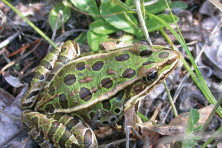Cigarette Snails & Fly-size Frogs
- Share
- Tweet
- Pin
- Share
• The cells that line the walls of blood capillaries and larger blood vessels in the brain form what is known as the blood-brain barrier. The name describes their function and underscores the importance of protecting brain cells from bacteria, viruses, and large molecules that might interfere with their function. Even antibodies are excluded from the brain proper, as are most drugs. On the other hand, the cells allow full access to glucose, the energy source of the brain, and certain hormones. Researchers at UW–Madison, a leading university in stem cell research, induced stem cells to grow into full-fledged brain-barrier cells in culture dishes. This means that scientists may be able to use these cells to develop a model system in which to persuade blood-brain cells to permit passage into the brain of molecules that could suppress tumor growth or otherwise enhance brain function. (Lippmann et al, Nature Methods, Aug. 30, 2012; 2011-12 report “The Year in Stem Cells,” Stem Cell &/Regenerative Medicine Center, UW–Madison; thanks to Chuck Mead)
• A part of our daily rhythm, a key hormone called melatonin is released at night to help induce sleep. Researchers at the Rensselaer Polytechnic Institute recently showed that two hours of iPad use at maximum brightness was sufficient to suppress a person’s normal nighttime release of melatonin. Laptop screens have the same effect. The researchers suggest dimming your glowing screen if you read on your iPad before trying to sleep – or switch to a hand-held book. (Scientific American Mind, Jan./Feb., 2013)
• Tropical marine snails belonging to the genus Conus are prized for their elongate and colorful shells, but some of them may also be important in the development of non-addictive painkillers for humans. Some grow to a foot in length, and all stun or kill their prey (small fish and other snails) by injecting them with a potent paralytic toxin. This is delivered by a harpoon-like structure shot out of the end of a long appendage that contacts prey. Conus geographus, a cone snail living in the Pacific Ocean, produces one of the most potent toxins known to man. Natives refer to this snail as the “cigarette snail,” because a person “stung” by the snail’s harpoon barely has time to smoke a cigarette before death ensues. Scientists are excited about components of the venom of cone snails, for some are 1,000 times stronger than morphine but without its addictive side effects. One scientist said that cone snails have “the largest and most clinically important pharmacological potential of any genus in nature.” (Scientific American Mind, Jan./Feb., 2013)
• The smallest known animal with a backbone is a fly-size frog newly discovered in leaf litter on the floor of New Guinea’s rain forest. Very hard to see and catch, the tiny critters can jump 30 times their own body length (a little over 7 mm.). They apparently feed on mites and other near-microscope invertebrates. (National Geographic, Jan. 11, 2012)



